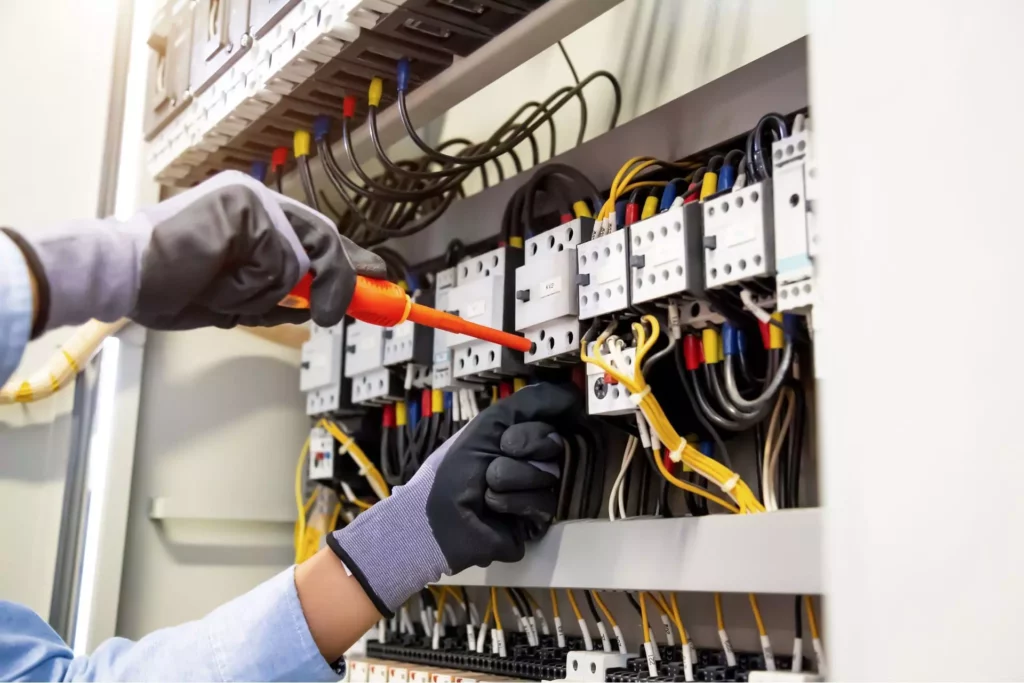[ad_1]
Introduction
Every circuit in your home uses a breaker and wire. The devices powered by the circuits require a certain amount of power, measured in amps, and the breaker and wire must be the correct size. Fifty amp circuits use fifty amp breakers. When installing a 50 amp circuit, it is critical to select the right 50 amp wire size.
Selecting the correct size wire is critical when installing a circuit, but precise wire sizing can be confusing. Whether you are looking to install a new 50 amp circuit yourself or you’d like to understand your home electrical system better, read ahead for more information about how to find the correct wire size for a 50 amp circuit.
Understanding 50 Amp Circuits

All the appliances in your home are connected to a circuit, and that circuit must have the correct amperage for the device. Most circuits in your home are 15 amp circuits, using 15 amp circuit breakers, which are sufficient for smaller devices, such as hair dryers, vacuum cleaners, and washing machines. but a few devices will require higher amperage.
Additionally, most homes have a few common high-draw items, such as electric dryers, air conditioners, and many electric cooking appliances. In many homes, the electrical range is the highest draw item, and these are usually installed on a 40-amp circuit breaker.
So what would a 50 amp circuit be used for? A hot tub is the most common household item requiring a 50 amp circuit breaker. Aside from hot tubs, another option is larger electric range, or electric cooktops. Lastly, electric heat can be a large draw, and an electric furnace or heat kit would require a 50 amp circuit or larger.
You may also want to install a 50 amp sub panel. Sub panels are useful in bringing electrical connections to other areas of your home. Like any other circuit, the circuit feeding a subpanel must have the correct circuit breaker and wire size. A 50 amp sub panel needs a 50 amp breaker and 50 amp wire.
Why Is Wire Size Important?
Every circuit is connected to a circuit breaker, and a 50 amp circuit will obviously use a 50 amp circuit breaker. Understanding the purpose and functionality of circuit breakers will help you understand the importance of selecting the correct wire size.
The purpose of circuit breakers is to protect the wire. A given thickness of wire can only handle so much electrical current. If the electrical current gets too high, the wire could start a fire. If the circuit breaker is correctly sized to the wire, then the breaker will trip when the current gets too high.
With this functionality in mind, you can see why it’s important to have the correctly sized breaker and wire. Having a circuit breaker that is too big for the wire (or wire that is too small for the breaker) poses a serious fire hazard.
Key Considerations for Choosing 50 Amp Wire Size

When selecting the correct gauge wire, there are a few key considerations, including the rating of the wire, the materials the wire is made of, and the total length of wire you will be using. Before working through those factors to find the 50 amp wire size, it is helpful to understand why wire gauge is important.
What Is Ampacity?
While electricity is the movement of electrons, ampacity is a measurement of how many electrons are flowing. A high-draw electrical device requires more electrical power, resulting in increased current flow. That means it will draw more electrons, which will generate more heat. And so, the wire size needs to be a suffecient thickness in order withstand the heat generated.
How Is Wire Size Measured?
Wire sizes are measured using the American Wire Gauge (AWG) measurement. The AWG scale indicates the thickness of the wire gauge size, and smaller numbers indicate a larger thickness of wire. Different voltages and different amps require different wire sizes. For example, most circuits in your home are 15 amp circuits, which require a #14 gauge wire.
What To Consider?
The first step is to consult the National Electrical Code, Table 310.16 (NEC 310.16), which gives you the maximum amps for each wire size. Although this will give you the maximum ampacity allowed for each wire gauge, there are two more important additional factors.
Wire Material
Wire can be either copper wire or aluminum. Although both are acceptable, which material you ultimately choose depends on considerations of cost and capacity. Generally speaking, copper wire is more expensive.
Distance
When a wire carries electricity a long distance, a certain amount of power is lost due to heat. The longer the wire, the more power is lost. When selecting a wire size, you will need to consider the distance to determine if the wire size needs to be increased so too much power is not lost.
Recommended Wire Sizes for 50 Amp Circuits
To size wire based on ampacity, the first step is to consult the National Electrical Code. In the NEC, you will find the wire size ampacity chart, Table 310.16, which gives you the rated amps for each wire size. Here, you will find that either #8 AWG copper wire or #6 AWG aluminum wire can handle 50 amps.
So, is #8 AWG copper the 50 amp wire size? In deciding the wire material, you must also consider the distance. If the length of your circuit is too long, then the wire size listed in the NEC may not be sufficient.
Copper Or Aluminum?
Although you may have heard aluminum wires are unsafe, this is only true for lower amperage circuits. Aluminum wires are safe and acceptable for a 50-amp circuit. You can confirm this by examining the specifications for any devices connected to the circuit.
Although aluminum wire is safe, it cannot handle as much heat as copper wires and therefore needs to be larger. Generally speaking, to handle 50 amps, copper wire needs to be of #8 gauge wire, while aluminum wire needs to be two sizes larger, #6 gauge wire. In other words, when using copper wires you can use smaller wire, and when using aluminum wire you will need to use bigger wire.
So, which material is better? Compare prices between the smaller and larger copper sizes and aluminum. As long as you have the correct size for the material, either is acceptable, so select the one that fits your budget.
Addressing Voltage Drop in Longer Runs
Unfortunately, no system is perfect, and electrical wires lose energy due to heat dissipation. This is why electrical wires get hot. This heat loss results in a circuit no longer having the voltage necessary to power your devices over too great a distance. This is called voltage drop, or voltage loss because the available voltage drops with the length of the wire.
As a general rule of thumb, once a circuit is around 100 feet long, you should stop and consider increasing your wire size to reduce voltage drop. Specific calculations can be found in the NEC, or provided by your local electrical authority.
When considering the length of a circuit, only consider the one-way circuit length. Voltage drop is a factor to consider for both aluminum and copper wires. By accounting for voltage drop, you can ensure that an appliance connected to the circuit is fully powered.
Types of Wires and Cables for 50 Amp Circuit Breakers
Although wire size is the most important factor when selecting your wire, there are different types of insulation and outer jackets that are used in a variety of environments. Here are the most common types of wire.
NMD or NM-B
Non-metallic cable, called either NMD or NM-B, is the most common style of wire used in home construction. It is only acceptable in dry and protected locations. In practice, this means that it is normally installed inside walls.
THHN/THWN
THHN/THWN is similar to NMD and NM-B, but with a thermoplastic insulation. This style of wire is suitable for wet locations.
UF-B
UF-B is similar to NMD and NM-B but has a more durable outer jacket. UF-B is suitable both for wet locations and for direct burial.
MC or AC
Metallic Cable or Armoured Cable has a flexible metal covering. This covering provides mechanical protection but does not provide water protection. Therefore, although it is only suitable for dry locations, it is a good option in open areas where the wire might be damaged.
TECK or ACWU
TECK cable (for copper) or ACWU (for aluminum cable) are acceptable for both wet and dry locations and acceptable for burial. It combines a flexible metal covering (for mechanical protection) with a hard outer covering (for water protection).
Installation Tips and Safety Considerations
When installing larger wire sizes, it’s essential to ensure the wire cannot be damaged. Secure the wire along the run with approved wire staples or straps. If the wire is running in an area where it may be damaged, find a method of protecting it, perhaps by installing it within walls or covering the wire with wood.
At any point where the wire enters a box, whether an outlet or device box, or the electrical panel, be sure to use the correct connectors. The wire must be protected from any sharp metal edges.
When stripping large wire, it’s important not to damage the conductor. Score the insulation with wire strippers, but don’t cut too deep. Then twist off the insulation, confirm that you have not nicked the wire, and cut off any strands.
When installing aluminum wires, a de-oxidized agent must be installed. Be sure to double-tighten your terminal screws and lugs. Aluminum wire experiences aluminum “flow”, and will loosing considerably if only tightened once.
Conclusion

In this article, we explored the critical aspects of installing a 50 amp circuit breaker, emphasizing the importance of matching the breaker with the correct wire size to ensure safety. Understanding the ampacity, the relationship between the circuit breaker and the wire, along with various factors influencing wire size, is essential for making informed decisions. This knowledge helps prevent potential fire hazards by avoiding incorrectly sized wires.
Phyxter Home Services stands out for its expertise and experience in providing high-quality information and services. Our team is well-versed in all safety standards and the National Electrical Code (NEC) guidelines, ensuring that every project we undertake is executed with the utmost precision and care.
We encourage our readers to delve into other insightful electrical articles on our platform to enhance their understanding further. If you’re looking for reliable and knowledgeable assistance with your electrical needs, consider using Phyxter Electrical Services. Let us help you ensure that your electrical installations are safe, efficient, and up to code.
[ad_2]
Source_link


